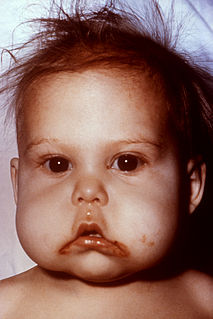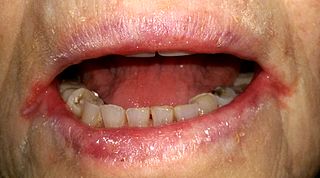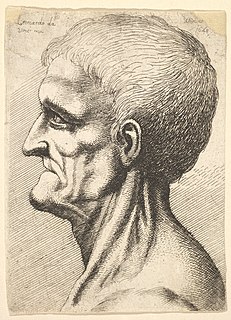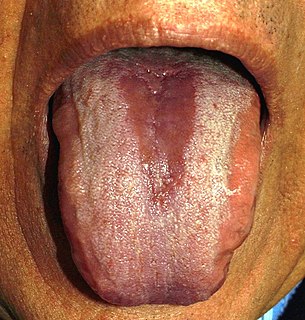Related Research Articles

Dentures are prosthetic devices constructed to replace missing teeth, and are supported by the surrounding soft and hard tissues of the oral cavity. Conventional dentures are removable. However, there are many denture designs, some which rely on bonding or clasping onto teeth or dental implants. There are two main categories of dentures, the distinction being whether they are used to replace missing teeth on the mandibular arch or on the maxillary arch.

Oral candidiasis, also known as oral thrush among other names, is candidiasis that occurs in the mouth. That is, oral candidiasis is a mycosis of Candida species on the mucous membranes of the mouth.

Oral leukoplakia is a potentially malignant disorder affecting the oral mucosa. It is defined as "essentially an oral mucosal white lesion that cannot be considered as any other definable lesion." Oral leukoplakia is a white patch or plaque that develops in the oral cavity and is strongly associated with smoking. Leukoplakia is a firmly attached white patch on a mucous membrane which is associated with increased risk of cancer. The edges of the lesion are typically abrupt and the lesion changes with time. Advanced forms may develop red patches. There are generally no other symptoms. It usually occurs within the mouth, although sometimes mucosa in other parts of the gastrointestinal tract, urinary tract, or genitals may be affected.

A dental implant is a prosthesis that interfaces with the bone of the jaw or skull to support a dental prosthesis such as a crown, bridge, denture, or facial prosthesis or to act as an orthodontic anchor. The basis for modern dental implants is a biologic process called osseointegration, in which materials such as titanium or zirconia form an intimate bond to bone. The implant fixture is first placed so that it is likely to osseointegrate, then a dental prosthetic is added. A variable amount of healing time is required for osseointegration before either the dental prosthetic is attached to the implant or an abutment is placed which will hold a dental prosthetic/crown.

Stomatitis is inflammation of the mouth and lips. It refers to any inflammatory process affecting the mucous membranes of the mouth and lips, with or without oral ulceration.
The oral mucosa is the mucous membrane lining the inside of the mouth. It comprises stratified squamous epithelium, termed "oral epithelium", and an underlying connective tissue termed lamina propria. The oral cavity has sometimes been described as a mirror that reflects the health of the individual. Changes indicative of disease are seen as alterations in the oral mucosa lining the mouth, which can reveal systemic conditions, such as diabetes or vitamin deficiency, or the local effects of chronic tobacco or alcohol use. The oral mucosa tends to heal faster and with less scar formation compared to the skin. The underlying mechanism remains unknown, but research suggests that extracellular vesicles might be involved.

Angular cheilitis (AC) is inflammation of one or both corners of the mouth. Often the corners are red with skin breakdown and crusting. It can also be itchy or painful. The condition can last for days to years. Angular cheilitis is a type of cheilitis.
Epulis fissuratum is a benign hyperplasia of fibrous connective tissue which develops as a reactive lesion to chronic mechanical irritation produced by the flange of a poorly fitting denture. More simply, epulis fissuratum is where excess folds of firm tissue form inside the mouth, as a result of rubbing on the edge of dentures that do not fit well. It is a harmless condition and does not represent oral cancer. Treatment is by simple surgical removal of the lesion, and also by adjustment of the denture or provision of a new denture.
An oral medicine or stomatology doctor has received additional specialized training and experience in the diagnosis and management of oral mucosal abnormalities including oral cancer, salivary gland disorders, temporomandibular disorders and facial pain, taste and smell disorders; and recognition of the oral manifestations of systemic and infectious diseases. It lies at the interface between medicine and dentistry. An oral medicine doctor is trained to diagnose and manage patients with disorders of the orofacial region, essentially as a "physician of the mouth."

Toothlessness or edentulism is the condition of having no teeth. In organisms that naturally have teeth, it is the result of tooth loss.
Stomatitis nicotina is a diffuse white patch on the hard palate, usually caused by tobacco smoking, usually pipe or cigar smoking. It is painless, and it is caused by a response of the palatal oral mucosa to chronic heat. A more pronounced appearance can occur with reverse smoking, sometimes distinguished from stomatitis nicotina by the term reverse smoker's stomatitis. While stomatitis nicotina that is caused by heat is not a premalignant condition, the condition that is caused by reverse smoking is premalignant.
Oral and maxillofacial pathology refers to the diseases of the mouth, jaws and related structures such as salivary glands, temporomandibular joints, facial muscles and perioral skin. The mouth is an important organ with many different functions. It is also prone to a variety of medical and dental disorders.

Median rhomboid glossitis is a condition characterized by an area of redness and loss of lingual papillae on the central dorsum of the tongue, sometimes including lesions of the tongue and palate. It is seen in patients using inhaled steroids and smokers, and is usually a kind of chronic atrophic oral candidiasis, but hematinic deficiency and diabetes should be excluded.
Oral pigmentation is asymptomatic and does not usually cause any alteration to the texture or thickness of the affected area. The colour can be uniform or speckled and can appear solitary or as multiple lesions. Depending on the site, depth, and quantity of pigment, the appearance can vary considerably.
Epulis is any tumor like enlargement situated on the gingival or alveolar mucosa. The word literally means "(growth) on the gingiva", and describes only the location of the mass and has no further implications on the nature of the lesion. There are three types: fibromatous, ossifying and acanthomatous. The related term parulis refers to a mass of inflamed granulation tissue at the opening of a draining sinus on the alveolus over the root of an infected tooth. Another closely related term is gingival enlargement, which tends to be used where the enlargement is more generalized over the whole gingiva rather than a localized mass.
Denture-related stomatitis is a common condition where mild inflammation and redness of the oral mucous membrane occurs beneath a denture. In about 90% of cases, Candida species are involved, which are normally a harmless component of the oral microbiota in many people. Denture-related stomatitis is the most common form of oral candidiasis. It is more common in elderly people, and in those who wear a complete upper denture. Denture-related stomatitis is more likely to develop when the denture is left constantly in the mouth, rather than removing it during sleep, and when the denture is not cleaned regularly.

Gingival cyst, also known as Epstein's pearl, is a type of cysts of the jaws that originates from the dental lamina and is found in the mouth parts. It is a superficial cyst in the alveolar mucosa. It can be seen inside the mouth as small and whitish bulge. Depending on the ages in which they develop, the cysts are classified into gingival cyst of newborn and gingival cyst of adult. Structurally, the cyst is lined by thin epithelium and shows a lumen usually filled with desquamated keratin, occasionally containing inflammatory cells. The nodes are formed as a result of cystic degeneration of epithelial rests of the dental lamina.
Alveoloplasty is a surgical pre-prosthetic procedure performed to facilitate removal of teeth, and smoothen or reshape the jawbone for prosthetic and cosmetic purposes. In this procedure, the bony edges of the alveolar ridge and its surrounding structures is made smooth, redesigned or recontoured so that a well-fitting, comfortable, and esthetic prosthesis may be fabricated or implants may be surgically inserted. This pre-prosthetic surgery which may include bone grafting prepares the mouth to receive a prosthesis or implants by improving the condition and quality of the supporting structures so they can provide support, better retention and stability to the prosthesis.
A complete denture is a removable appliance used when all teeth within a jaw have been lost and need to be prosthetically replaced. In contrast to a partial denture, a complete denture is constructed when there are no more teeth left in an arch, hence it is an exclusively tissue-supported prosthesis. A complete denture can be opposed by natural dentition, a partial or complete denture, fixed appliances or, sometimes, soft tissues.

Overdenture is any removable dental prosthesis that covers and rests on one or more remaining natural teeth, the roots of natural teeth, and/or dental implants. It is one of the most practical measures used in preventive dentistry. Overdentures can be either tooth supported or implant supported. It is found to help in the preservation of alveolar bone and delay the process of complete edentulism.
References
- 1 2 Rajendran A, Sundaram S (10 February 2014). Shafer's Textbook of Oral Pathology (7th ed.). Elsevier Health Sciences APAC. p. 541. ISBN 978-81-312-3800-4.
- ↑ Ghom AG, Ghom SA (30 September 2014). Textbook of Oral Medicine. JP Medical Ltd. pp. 305–306. ISBN 978-93-5152-303-1.
- ↑ Barnes L (2009). Surgical pathology of the head and neck, vol. 1 (3rd ed.). New York: Informa Healthcare. pp. 220–221. ISBN 978-0849390234.
- 1 2 3 Gual-Vaqués P, Jané-Salas E, Egido-Moreno S, Ayuso-Montero R, Marí-Roig A, López-López J (January 2017). "Inflammatory papillary hyperplasia: A systematic review". Medicina Oral, Patologia Oral y Cirugia Bucal. 22 (1): e36–e42. doi:10.4317/medoral.21405. PMC 5217495 . PMID 27918740.
- 1 2 3 4 5 Bouquot JE, Muller S, Nikai H (2009). "Chapter 4 - Lesions of the Oral Cavity". In Gnepp DR (ed.). Diagnostic Surgical Pathology of the Head and Neck (Second ed.). W.B. Saunders. pp. 191–308. ISBN 9781416025894.
- 1 2 Neville BW, Damm DD, Allen CM, Chi AC. "Soft Tissue Tumors". Oral and Maxillofacial Pathology (4th ed.). pp. 473–532.
- 1 2 Fisher AK, Rashid PJ (February 1952). "Inflammatory papillary hyperplasia of the palatal mucosa". Oral Surgery, Oral Medicine, and Oral Pathology. 5 (2): 191–8. doi:10.1016/0030-4220(52)90034-0. PMID 14891213.
- ↑ Fairchild JM (March 1967). "Inflammatory papillary hyperplasia of the palate". The Journal of Prosthetic Dentistry. 17 (3): 232–7. doi:10.1016/0022-3913(67)90085-6. PMID 5226412.
- ↑ Turck D (May 1965). "A histologic comparison of the edentulous denture and non-denture bearing tissues". The Journal of Prosthetic Dentistry. 15 (3): 419–34. doi:10.1016/s0022-3913(65)80010-5. PMID 14277472.
- 1 2 3 Lambson GO, Anderson RR (December 1967). "Palatal papillary hyperplasia". The Journal of Prosthetic Dentistry. 18 (6): 528–33. doi:10.1016/0022-3913(67)90217-x. PMID 4863770.
- ↑ Wilson J (October 1998). "The aetiology, diagnosis and management of denture stomatitis". British Dental Journal. 185 (8): 380–4. doi:10.1038/sj.bdj.4809821. PMID 9828496.
- ↑ Ritchie GM, Fletcher AM, Main DM, Prophet AS (August 1969). "The etiology, exfoliative cytology, and treatment of denture stomatitis". The Journal of Prosthetic Dentistry. 22 (2): 185–200. doi:10.1016/0022-3913(69)90246-7. PMID 5256067.
- ↑ Yrastorza JA (July 1963). "Inflammatory papillary hyperplasia of the palate". Journal of Oral Surgery, Anesthesia, and Hospital Dental Service. 21 (3): 330–6. PMID 14002866.
- ↑ Goulart MC. Hiperplasia papilar: análise quantitativa de Candida albicans no revestimento epitelial e sua correlação com as características microscópicas (Thesis). Universidade de Sao Paulo Sistema Integrado de Bibliotecas - SIBiUSP.
- ↑ Ferreira RC, Magalhães CS, Moreira AN (September 2010). "Oral mucosal alterations among the institutionalized elderly in Brazil". Brazilian Oral Research. 24 (3): 296–302. doi: 10.1590/s1806-83242010000300007 . PMID 20877966.
- ↑ da Silva HF, Martins-Filho PR, Piva MR (September 2011). "Denture-related oral mucosal lesions among farmers in a semi-arid Northeastern Region of Brazil". Medicina Oral, Patologia Oral y Cirugia Bucal. 16 (6): e740-4. doi: 10.4317/medoral.17081 . PMID 21196849.
- ↑ Altarawneh S, Bencharit S, Mendoza L, Curran A, Barrow D, Barros S, Preisser J, Loewy ZG, Gendreau L, Offenbacher S (January 2013). "Clinical and histological findings of denture stomatitis as related to intraoral colonization patterns of Candida albicans, salivary flow, and dry mouth". Journal of Prosthodontics. 22 (1): 13–22. doi:10.1111/j.1532-849x.2012.00906.x. PMC 3541428 . PMID 23107189.
- ↑ Poulopoulos A, Belazi M, Epivatianos A, Velegraki A, Antoniades D (September 2007). "The role of Candida in inflammatory papillary hyperplasia of the palate". Journal of Oral Rehabilitation. 34 (9): 685–92. doi:10.1111/j.1365-2842.2007.01758.x. PMID 17716268.
- ↑ Coelho CM, Sousa YT, Daré AM (February 2004). "Denture-related oral mucosal lesions in a Brazilian school of dentistry". Journal of Oral Rehabilitation. 31 (2): 135–9. doi:10.1111/j.1365-2842.2004.01115.x. PMID 15009597.
- ↑ Pattanaik S, Vikas BV, Pattanaik S, Sahu S, Lodam S (January 2015). "Denture Stomatitis: A Literature Review". Journal of Orofacial and Health Sciences. 6 (2): 2.
- ↑ Cutright DE (April 1975). "Morphogenesis of inflammatory papillary hyperplasia". The Journal of Prosthetic Dentistry. 33 (4): 380–5. doi:10.1016/s0022-3913(75)80033-3. PMID 1054416.
- 1 2 Orenstein NP, Taylor T (April 2014). "A nonsurgical approach to treating aggressive inflammatory papillary hyperplasia: a clinical report". The Journal of Prosthetic Dentistry. 111 (4): 264–8. doi:10.1016/j.prosdent.2013.07.020. PMID 24360006.
- ↑ Emami E, Taraf H, de Grandmont P, Gauthier G, de Koninck L, Lamarche C, de Souza RF (February 2013). "The association of denture stomatitis and partial removable dental prostheses: a systematic review". The International Journal of Prosthodontics. 25 (2): 113–9. doi:10.1016/s0022-3913(13)60029-3. PMID 22371829.
- ↑ Woo S (November 2016). Oral Pathology (2nd ed.). Elsevier. ISBN 978-0-323-39054-5.
- ↑ Gnepp DR (2009). Diagnostic Surgical Pathology of the Head and Neck (2nd ed.). London: Elsevier Health Sciences. ISBN 978-1-4160-2589-4.
- 1 2 Oral and Maxillofacial Pathology (4th ed.). Elsevier.
- ↑ Schmitz JF (November 1964). "A clinical study of inflammatory papillary hyperplasia". Journal of Prosthetic Dentistry. 14 (6): 1034–1039. doi:10.1016/0022-3913(64)90170-2.
- ↑ Bolender CL, Swenson RD, Yamane G (1965-11-01). "Evaluation of treatment of inflammatory papillary hyperplasia of the palate". The Journal of Prosthetic Dentistry. 15 (6): 1013–22. doi:10.1016/0022-3913(65)90178-2. PMID 5213447.
- ↑ Cutright DE (April 1975). "Morphogenesis of inflammatory papillary hyperplasia". The Journal of Prosthetic Dentistry. 33 (4): 380–5. doi:10.1016/S0022-3913(75)80033-3. PMID 1054416.